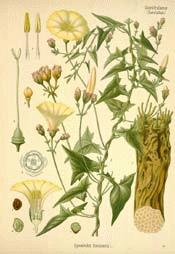
Botanical.com Home Page
Bindweed, SyrianBotanical: Convolvulus Scammonia---Synonym---Scammony.---Habitat---The Syrian Bindweed, or Scammony (C. Scammonia), can be grown here and will thrive well on dry soil, but we import from Smyrna and Aleppo what is needed for medicinal purposes.
---Description---It has flowers of a very delicate tint of sulphur yellow and leaves of a similar shape to our native species. The roots are 3 to 4 feet long and from 9 to 12 inches in circumference; tapering, covered with a light grey bark and containing a milky juice. Scammony is a gummy resin, obtained from this milky juice of the root by clearing away the earth from the upper part of the root and cutting off the top obliquely, about 2 inches below where the stalks spring. Then a vessel is fixed in such a position as to receive the exuding juice, which gradually hardens and becomes the Scammony of commerce. The best Scammony is black, resinous and shining when in the lump, but of a whitish-ash colour when powdered, with a strong cheesy smell and a somewhat acrid taste, turning milky when touched by the tongue. It occurs in commerce in irregular pieces 1 to 2 inches or more in diameter. ---Medicinal Action and Uses---Scammony is a drastic cathartic, closely allied in its operation to Jalap; though not so nauseous, it is more active and irritating, and in inflammatory conditions of the alimentary canal should not be used. The root itself is seldom used: the resin prepared from it is generally combined with other cathartics to diminish its action and prevent griping. [Top] ---Preparations---Powdered root, 3 to 12 grains. Powdered resin, B.P., 3 to 8 grains. Compound Powder, B.P., 10 to 20 grains. It appears to have been well known to the Greek and Arabian physicians, who used it for various other purposes as well as for a purgative. The dose is generally from 3 to 12 grains. Seven grains of Scammony resin gradually rubbed well up with 3 oz. milk forms a safe purgative, to which a taste of ginger can be added. It is used as a smart purge for children, especially for those with worms, on account of the smallness of the dose necessary to produce its effect, the slight taste and the energy of its operation. It is useful as a hydragogue in dropsies. Meyrick considered it a rough and powerful, but very useful purgative of great service in rheumatic and other chronic disorders, reaching the seat of many sources of trouble that an ordinary purge does not affect. The leaves of the Sea Bindweed abound with a milky juice which has been employed as a purge - in 1/2 oz. doses. Applied externally, the leaves are reputed to diminish dropsical swelling of the feet. The whole plant used to be gathered fresh, when about to Hower, and boiled in ale, with nutmegs and cloves, and the decoction given as a strong purge, which was said to be best adapted to robust constitutions, being very violent in its action. The juice oozing from the stalks and root of the Sea Bindweed hardens into a kind of resin, which is also used as a purge in the same way as Scammony - a closelyrelated plant of foreign origin, which is much imported for this purpose. Both the preceding species of Convolvulus also possess the virtues of Scammony. The smallness of their roots prevents the juice being collected in the same way as the foreign species, but an extract made from the expressed juice of the roots or any preparation of them has the same purgative quality, only in less degree. Meyrick states that the root of C. arvensis is a rough purgative, and to such constitutions as can bear it, will prove serviceable in jaundice, dropsy and other disorders arising from obstructions of the viscera, the best method of administering it being to bruise the roots and give their expressed juice in strong beer. The juice of theGreater Bindweed, taken in doses of 20 to 30 grains is also a powerful drastic purge, and country people often boil its freshly-gathered roots in ale in the same manner as the Field Bindweed. Though for those of a strong constitution there is no better purge, on account of the nausea which it tends to produce, it is not considered fit for the delicate. [Top]
A tincture of the flowers is used for headaches, rheumatism and inflamed eyes.
See (FIELD) CONVOLVULUS.
[Top]
© Copyright Protected 1995-2025 Botanical.com
|
